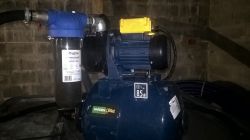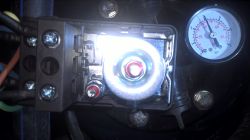FAQ
TL;DR: Minimum 2 bar is needed for plastering machines; "This tank can't handle any pressure." Use a hydrophore or submersible pump, not a compressor or pressurized IBC. [Elektroda, soniak2, post #17489666]
Why it matters: For renovators feeding plastering machines from a 1000 L IBC without mains, safe, steady pressure avoids damage and delays.
Quick Facts
- Plastering machines need about 2 bar at the inlet for proper operation. [Elektroda, soniak2, post #17489666]
- Typical water use: ~1000 L/100 m² (gypsum) or ~500 L/100 m² (cement‑lime). [Elektroda, freebsd, post #17489808]
- IBC tanks visibly deform at ~4 bar—do not pressurize them. [Elektroda, freebsd, post #17489664]
- Pump spec many crews use: AV 3000, ~5.5 bar, ~3000 L/h, 600 W. [Elektroda, freebsd, post #17489808]
- Set hydrophore precharge ~0.2 bar below start pressure via the Schrader valve. [Elektroda, Covul, post #17536289]
Can I pressurize a 1000 L IBC (Mauzer) tank with a compressor?
No. An IBC is not a pressure vessel and can fail dangerously. “This tank can't handle any pressure.” Use a hydrophore or a proper pump to feed the machine. A compressor adds unsafe, fluctuating pressure and air. [Elektroda, soniak2, post #17489666]
Will an IBC survive 3–4 bar?
At around 4 bar, IBC walls deform in video tests. “It doesn't look good.” Treat IBCs as atmospheric storage only. For pressure, install a pump on the outlet with suitable plumbing. [Elektroda, freebsd, post #17489664]
What pressure do plastering machines need to run?
Plan for at least 2 bar at the machine inlet. That level allows proper operation of many plastering aggregates. Keep lines short and unobstructed to maintain set pressure. [Elektroda, soniak2, post #17489666]
How much extra pressure should I allow for hoses and height?
Add about 0.5 bar to cover hose losses and elevation changes. This buffer helps keep the aggregate stable during continuous draw. [Elektroda, freebsd, post #17489664]
How much water do I need for gypsum or cement‑lime plaster?
Approximate usage: 1000 liters per 100 m² for gypsum plasters. Cement‑lime plasters need about 500 liters per 100 m². Reserve extra water for cleaning the machine and tools. [Elektroda, freebsd, post #17489808]
How much water does one 30 kg bag require?
Expect about 16 liters per 30 kg bag. Keep additional water for washing equipment and lines after runs. [Elektroda, soniak2, post #17489758]
What pump specs work best with plastering machines?
Use a pump designed for aggregates. Example: AV 3000 offers ~5.5 bar pressure, ~3000 L/h flow, and 600 W. These parameters sustain pressure under continuous operation. [Elektroda, freebsd, post #17489808]
My submersible pump won’t fit the tank opening. What can I use?
Choose a slim deep‑well submersible with a small required hole, e.g., 110 mm. A 600 W Hecht unit lists 70 m head and 110 mm minimum hole diameter. Verify your tank cap size before purchase. [Elektroda, freebsd, post #17489808]
How do I set my hydrophore’s start/stop and tank precharge?
- Cut power and open an outlet. Adjust the pressure switch: large spring sets start pressure; small spring sets hysteresis.
- Under the black cap, set air precharge via the Schrader valve to 0.2 bar below start pressure.
- Close the outlet and test under flow. These settings don’t increase pump efficiency. [Elektroda, Covul, post #17536289]
Can raising the air pressure in the hydrophore tank increase flow?
No. Precharge affects cycling and drawdown, not pump output or efficiency. Changing start/stop pressures also does not increase pump efficiency. Improve flow by plumbing or pump sizing instead. [Elektroda, Covul, post #17536289]
Why do I only see about 1 bar when the valve is fully open?
Your pump has reached its flow limit at that opening. It cannot build more pressure while delivering that volume. Partially close the valve to raise pressure, or upgrade the pump. [Elektroda, Covul, post #17536289]
How long will 1000 L last if I plan 350 m² of gypsum?
At ~1000 L per 100 m², 350 m² needs about 3500 L. Two 1000 L tanks cover roughly 200 m². Arrange additional water for the remainder and cleanup. [Elektroda, freebsd, post #17489808]
Is using a neighbor’s tap a viable workaround?
Yes, if available. A neighbor’s tap was suggested as a practical alternative to on‑site pressurization. Confirm pressure and access before scheduling work. [Elektroda, soniak2, post #17489666]
Does placing the tank 1 m below the machine affect pressure?
Elevation reduces available inlet pressure. Choose a pump with ample head, such as ~5.5 bar, to cover losses and lift. Aggregate‑rated pumps meet these requirements reliably. [Elektroda, freebsd, post #17489808]
Is strapping the tank a safe way to pressurize it?
No. Even with straps, plastic IBCs deform at higher pressures. A video shows visible deformation at ~4 bar. Treat IBCs as non‑pressurized containers. [Elektroda, freebsd, post #17489664]





